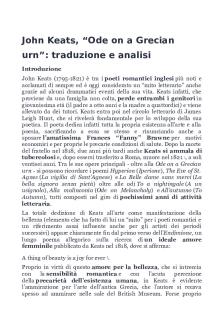Reading Response Ode on a Grecian Urn Keats PDF

| Title | Reading Response Ode on a Grecian Urn Keats |
|---|---|
| Author | Claire Mo |
| Course | Honors Western Humanities 2: Renaissance to the Present |
| Institution | Brigham Young University |
| Pages | 1 |
| File Size | 52.1 KB |
| File Type | |
| Total Downloads | 60 |
| Total Views | 148 |
Summary
weekly writing assignment ...
Description
Moore 1 Claire Moore IHUM 202 Professor Haddock 20 May 2020 Reading Response Ode On a Grecian Urn In Keats’ poem, Ode On a Grecian Urn, he uses detailed descriptions of the scenes depicted on ancient Greek vase to explain how art and poetry are more beautiful than mortal life because they do not grow old and die, but withstand the test of time. In the second stanza, Keats captures an idyllic scene that includes a musician, trees, and a young lover. He writes that the music of the musician, though unheard, is more beautiful than any actual music, because we imagine it as the ideal as we cannot actually hear the sounds being played. He also says that the trees will never be barren, because the healthy and full-of-life representation of their leaves is frozen in the vase and will not change. Last of all, Keats longingly explains that, though the man will never kiss his Love, it is better this way because they will always be together and will never age or die. At the end of his poem, he writes, “When old age shall this generation waste, Thou shalt remain” (Keats 46-47). Keats is saying that humans will eventually grow old and die because we are mortal. Beautiful things, like the human body, buildings, and nature, begin to decay with time. He is almost envious of the figures on the urn because he recognizes that the state they are in is permanent. Ultimately, this is Keats’ message; art and poetry are the highest forms of beauty because they are eternal....
Similar Free PDFs

John Keats-Ode on a Grecian Urn
- 10 Pages

Lit Charts-ode-on-a-grecian-urn-1
- 16 Pages

ODE TO Autumn - John Keats
- 5 Pages

QUIZ on Keats Week 1
- 9 Pages

Ode a Cassandre essay
- 2 Pages

Reading Response 4
- 2 Pages

Reading response English 121G
- 3 Pages

Reading Response #4
- 2 Pages

Week 14 Reading Response
- 1 Pages
Popular Institutions
- Tinajero National High School - Annex
- Politeknik Caltex Riau
- Yokohama City University
- SGT University
- University of Al-Qadisiyah
- Divine Word College of Vigan
- Techniek College Rotterdam
- Universidade de Santiago
- Universiti Teknologi MARA Cawangan Johor Kampus Pasir Gudang
- Poltekkes Kemenkes Yogyakarta
- Baguio City National High School
- Colegio san marcos
- preparatoria uno
- Centro de Bachillerato Tecnológico Industrial y de Servicios No. 107
- Dalian Maritime University
- Quang Trung Secondary School
- Colegio Tecnológico en Informática
- Corporación Regional de Educación Superior
- Grupo CEDVA
- Dar Al Uloom University
- Centro de Estudios Preuniversitarios de la Universidad Nacional de Ingeniería
- 上智大学
- Aakash International School, Nuna Majara
- San Felipe Neri Catholic School
- Kang Chiao International School - New Taipei City
- Misamis Occidental National High School
- Institución Educativa Escuela Normal Juan Ladrilleros
- Kolehiyo ng Pantukan
- Batanes State College
- Instituto Continental
- Sekolah Menengah Kejuruan Kesehatan Kaltara (Tarakan)
- Colegio de La Inmaculada Concepcion - Cebu






